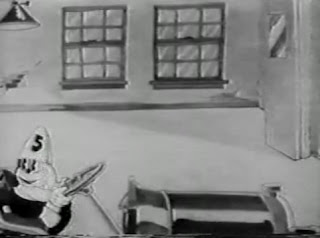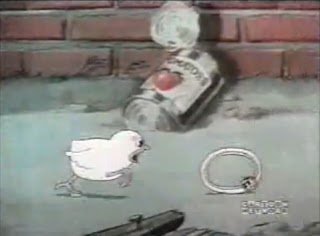 |
| Title card courtesy of Dave Mackey. |
featuring Ham and Ex. (plus Beans).
Warner cartoon no. 119.
Release date: December 23, 1935.
Series: Looney Tunes.
Supervision: Jack King.
Producer: Leon Schlesinger.
Starring: Bernice Hansen (Ham and Ex).
Musical Score: Norman Spencer.
Animation: Bob McKimson and Ben Clopton.
Sound: Treg Brown (uncredited).
Well, I'm going to declare this as the last cartoon of 1935 at Warner Bros since the release date is later than Flowers for Madame. I believe this is also the first Warner Bros. cartoon to use the "That's all, folks" writing at the end. It's also 29th February - so let's not leap death... ;-)
Beans is doing his job as a fireman inside the fire station called Fire Station No. 5 which suggests that there are different fire stations in the town or community Beans lives in. Beans is shown polishing the fire engine inside the station to make it all polished and shiny.
The two twin puppies; Ham and Ex are outside in the streets both on one scooter riding past several people standing on the street. They are on their scooter until they arrive at the fire station where Beans works. Ham and Ex then shout "Uncle Beans" to know that Ham and Ex have arrived. Beans then arrives at the scene in which Ham and Ex give him a note and Beans reads the note: Uncle Beans, Please take care of Ham and Ex. Have gone shopping. Lizzie. Lizzie appears to be the mother I imagine.
 Beans has finished reading the note and is rather confused as he doesn't know what to do with both Ham and Ex about. Beans is really unsure until he finally gives in and takes both Ham and Ex inside the fire station. Ham and Ex prance around the room excitedly while Beans is rather confused as he scratches his head.
Beans has finished reading the note and is rather confused as he doesn't know what to do with both Ham and Ex about. Beans is really unsure until he finally gives in and takes both Ham and Ex inside the fire station. Ham and Ex prance around the room excitedly while Beans is rather confused as he scratches his head.Ham and Ex then start to fight over a hat on the stool as though they both want to wear it. They have a tug-of-war game on the hat until Ham (I presume) has a boot stuck on his head. It's really hard to tell who's got the boot stuck on it's head first considering they are IDENTICAL. Ham then throws the hat away and throws it at (probably Ex; I'm just going by the order of their name and appearance). The boot stuck on Ex and then chucks it out of the way.
After the boot is chucked out of the way; they are both dancing about as the fireman hat is basically torn apart with each of the twin having a share. They both then start to run to the next part where they encounter a fire engine. The twins then start to tug the axe off the engine but one of the twins (I'll say Ham since he's wearing the flat part of the hat) then slides out of the scene with the axe attached to a pole in the station.
Ex (who knows?) grabs out a hose from the fire truck and starts to position himself holding onto the hosepipe. Ex then starts to move the hosepipe around in which it eventually covers the entire fire truck. Ham (I presume) then lets go of the axe from the pole and follows Ex where he is busy with the fire truck.
Ham then follows Ex as the fire station is completely tangled with hosepipes all over the place. mischievous twins. The twin then starts to turn on the hosepipe which leaves a crazy sequence that follows Ex being sucked behind the hosepipes as it starts to loosen and then he swirls around the hosepipe until he goes off flying.
That was a rather entertaining part with that sound effects that would later be used for the Tasmanian Devil. I imagine that the hosepipe sequence would've been difficult to animate. Ex then flies out of the hosepipe and lands on Uncle Beans who is busy cleaning the floors with a scrub. Ex (I'm only going to estimate with the hats they're wearing) then accidentally slips on a sponge which squirts Beans and Ham.
Beans then starts to get up from his behind as he grabs both Ham and Ex in the ears. He places the twin pups on a bench as a punishment for their behaviour. He is walking around to make sure that they don't even make a sound but does turn around and shouts "Queit!" when they do make a sound. He then walks out of the scene.
Ham and Ex then starts to blow raspberries at them with that funny sound effect gag and then start to fiddle again but with the fire alarm. I imagine that Treg Brown was probably with the studio by that time which I'm certain so I'll include him in the credits list for the remainder even though he has been uncredited for most of his career.
The dungarees then turn inanimate and tries to wake up the sleeping fireman and then eventually wakes up. The fireman realizes that there is a fire alarm going on until he finally wakes up to join the rest of the fireman when they jump into the fire truck and they then leave the station in a rush. There is weird animation of the fire truck as it's about to start up but then rushes out of the scene. Ham and Ex's prank worked well.
Ham and Ex then start to go into song as they hold their hands and they run around in circles going into a melody singing Norman Spencer's song that is played during the entire score How We Like to Fool the Firemen. The singing of Ham and Ex and their dancing is really annoying to look at; and Bernice Hansen's singing adds the touch to it.
Ham and Ex then do one of 'em Jack King hat-takes as the fire engine returns as the firemen know there is no fire. Ham and Ex then run out of the scene as the fire truck returns to the room. Ham and Ex sit on the bench to act innocent.
Beans approaches the bench where Ham and Ex are sitting and knows that they have played the prank on the firemen. Beans thinks about what to do with the mischievous twin pups but thinks of an idea of what to do with those twins.
Beans gives both Ham and Ex a sanction which is going to bed early. He tucks them into bed upstairs where the fireman sleep. He then shouts "Now GO TO SLEEP!" until he walks out of the scene. As Beans leaves the scene Ham and Ex both go jumping about on the beds bouncing from bed-to-bed.
They both continue to jump and almost cause accidents and then they slide down the poll where the firemen go for emergencies. They both jump onto the fire truck when Beans is busy sorting out the tools. The fire truck has already turned on once Beans turns around to find out Ham and Ex are driving the engine.
The fire truck drives into a wall in which Beans tries his best to chase after the truck. He almost gets run over by it as he is currently in front of the truck in the middle of the road. Beans is saves as he falls down an open manhole.
Ham and Ex are still driving the fire truck as the truck is moving from left to right crashing telephone poles and ruining most of the streets in the town. They start to mess up the shrubs in the street by cutting most of it off. They also mess up a statue in which the horse and man jump up but are not back into accurate positions.
They crash into a house where a man is already occupied on the telephone. A trolley in the tracks is already cycling past but the fire truck then starts to turn it looking all topsy-turvy. Blimey that truck is going all over the place. We see some pretty neat effects from a helicopter view of the city in which it's going all over the place through buildings of a town center. The fire truck then arrives back at the fire engine that as they walk up the stairs thinking Beans doesn't know anything about it.
They rush up the stairs pretending that nothing happened but nobody is falling for the scene of course. They then run back into the fire station dormitory pretending to be asleep but Beans runs into the beds where Ham and Ex are sleeping knowing what shenanigans they had been up to.
Beans has already approached the scene in which he continuously looks at both of them and already knows they're faking their sleep. He comes up with a plan to sneakily hide in the dormitory where they won't be seen so Ham and Ex would no longer attempt to cause trouble.
Beans hides behind a wall but Ham and Ex wake up thinking that he has gone but they notice that he is trying to play a trick on both Ham and Ex. Ex then throws a boot at Beans in which he starts to spin around at the same position over and over again. This is finally the last straw for Beans.
Ham and Ex both dance around in the bed cheering on what happened to Beans but then he returns to the bed and the sanction for both Ham and Ex is spanking. Beans seems to pull the noses of their backside pants upwards so that he can spank them.
Overall comments: Jack King and Tex Avery were clearly put in charge of the "Beans" group in 1935-1936 for the Looney Tunes but Avery focused on Porky Pig to potential the character's career while Jack King mainly focused on the other characters such as Beans, Ham and Ex, etc. and giving them a chance to appear in a cartoon at a time - and that's what King did in this cartoon for Ham and Ex. Ham and Ex's cartoon here so far is just kind of annoying to watch but I didn't really have much to complain except that the only part of their personality is that they're mischievous and nothing else. Beans plays a minor role in this cartoon and he very rarely speaks in this cartoon if you've noticed.
Well that's 1935 completed. This year I've proven on how that 1935 was certainly an improvement from 1934; and there have been some importance in this year. The first appearance of Porky Pig, Buddy is finally out of his cartoon career for good, and the arrival of Tex Avery. So it means that next year - there will be some improvement but only gradually. It will take about a couple of years until the Looney Tunes have been perfected.






















































